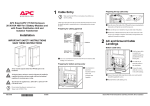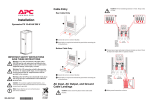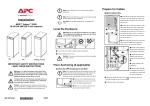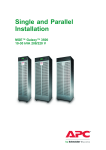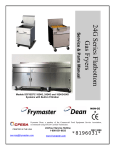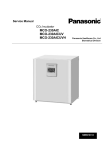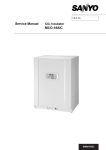Download APC VT ISX Specifications
Transcript
1 Preparing for Cabling ® Make sure the UPS is in its location of use before wiring begins. Note The UPS must be supplied from a: 480Y/277V 4W + GND or 480V 3W + GND 60Hz source. Smart-UPS® VT ISX Installation Warning Caution Important Safety Instructions – SAVE THESE INSTRUCTIONS Verify clockwise phase-rotation (L1, L2, L3) and make sure a neutral connection is present. Cut crosses for cable access in the required number of the 6 blanking plugs (use top blanking plugs for top entry, bottom blanking plugs for bottom entry). Line hole(s) with grommets. The installation must comply with all national codes. Preparing for bottom entry cabling Caution Power terminal lug diameter: minimum 6 mm. Torque value: 45 lbf.in/5 Nm. Note Preparing for cabling (general) Remove the 2 M4 screws from the bottom plate and remove plate. Punch holes in the labeled area of the bottom plate for conduits as required. Line hole(s) with grommets. Preparing for top entry cabling Always read the separate Safety sheet (990-2822) prior to the installation. Note Always carry out the Total Power Off procedure prior to the installation. Refer to the Safety sheet (990-2822) for details. Warning Warning Rear Rear All electrical power and power control wiring must be installed by a qualified electrician, and must comply with local and national regulations for maximum power rating. Pull out the lower end of the handle and turn the handle counterclockwise to a horizontal position to open the door. Using a torx screwdriver, loosen the 12 M4 screws from the cable landing covers and remove. From the rear of the inside of the UPS push the two top cover spring locks backwards to lift up rear end of top plate. Slide out the top plate (mind the wing on either side of the plate). Punch holes in the top plate for conduits in labeled area as required. Line hole(s) with grommets. 990-2870 *990-1747C* 01/2006 Smart-UPS® VT ISX w/transformer, 20-30 kVA, 480 V, Installation 2 Top entry Input Cabling Feed the input Bottom entry cable in conduits through the punched holes in the top. 3 Battery Cabling The UPS may ONLY be connected to the APC SUVTBXR Battery Enclosure. Note Bottom cabling entry Attach the cable to the side panel using cable ties Guide the input cable through the blanking plugs. L3 L1 L2 Attach to slotted PE Connect the input cables (L1,L2,L3) to the cable landings using a torx screwdriver. Feed the input cables in conduits through holes in the bottom entry. Guide the input cables through the blanking plugs and use cable ties Connect the PE cable using the provided earth screw (earth symbol beneath the applicable screw). to attach the cables to the slotted plate. Connect the input cables (L1, L2, L3) to the cable landings using a torx screwdriver. Connect the PE cable using the provided earth screw (earth symbol beneath the applicable screw). L1 L3 Reinstall the L2 Smart-UPS® VT ISX w/transformer, 20-30 kVA, 480 V, Installation plate. PE Remove the top cable landing plates. Feed the battery cables through the punched holes in the bottom plate. Guide the cables through the blanking plugs. Use cable ties to attach the cable to the slotted plate. Connect the battery cables Bat+ and Bat– and the N cable in the designated areas (indicated on the PCB behind the cable landing area). bottom cable landing plate. Smart-UPS® VT ISX w/transformer, 20-30 kVA, 480 V, Installation to EPO, 4 Communication Batteries, and Options Top cabling entry Connect the EPO cable, using one of the following 4 wiring configurations. Always follow the pin connection procedures from the top and work down: J106 (8-1), J108 (1-6). EPO switch must be connected to a NEC Class 2 wiring. Note Note Use only 28-16 AWG copper wire for the connection of the Emergency Power Off (EPO) and other optional equipment. Keep all other wiring and uninsulated live parts separate of other NEC Class 2 circuits. Do not connect any circuits to the EPO terminal block unless it can be confirmed that the circuit is a NEC Class 2 circuit. Note Note 1: Dry Contracts Normally Open J108 1 2 3 4 5 6 2: +24V Normally Open J108 1 2 EPO switch wiring – pin connections J108 (for EPO wiring options) 6 3: Dry Contacts Normally Closed 1 2 3 4 EPO circuit 5 Connect Bat+ and Bat– and N as described under bottom cabling. 6 4: +24V Normally Closed J106 Pin Connections: 8 Ext. charging control return 7 External control of charging J108 Pin Connections: 6 Q3 active return 1 Normally open EPO 5 Q3 active 2 Normally open EPO return 4 Battery measurement supply* 3 Normally closed EPO 3 Battery unit quantity* 4 Normally closed EPO return 2 Max. battery temperature* 5 +24V SELV supply 1 Battery measurement return* 6 SELV ground * Should be used with APC XR Enclosures The UPS must be connected to either a dry contact or a 24 VDC Emergency Power Off (EPO) switch. Note EPO is activated when a SELV 24VDC voltage removed from pin 3 with reference to pin 5. J108 1 2 3 4 EPO circuit 5 6 Pin connections J106 (UPS) J106 8 Charging control switch 7 6 Q3 switch 5 Smart-UPS® VT ISX w/transformer, 20-30 kVA, 480 V, Installation EPO is activated when a connection from pin 3 to pin 5 is opened. J108 Use cable ties to attach the cables to the side panel and slotted plate. See also EPO is activated when an isolated SELV 24VDC voltage is supplied on pin 1 with reference to pin 2. 5 Guide the cables through the blanking plugs. For configurations including customer-supplied external batteries, refer to manufacturer’s battery installation and maintenance instructions. EPO circuit 3 4 Remove the top cable landing plates. Feed the battery cables through the punched holes in the top plate. EPO circuit EPO is activated when pin 1 is connected to pins 3 and 5. 4 4 3 3 2 2 1 1 J200 (XR Batteries) Smart-UPS® VT ISX w/transformer, 20-30 kVA, 480 V, Installation Pins 1 to 4 are for battery measurement (only applicable to APC XR Enclosures). Pins 5 and 6 are for external maintenance bypass Q3 (auxiliary switch N/C type). When Q3 is closed, signals are fed back to the UPS controller. Pins 7 and 8 are for external charge control. When 7 and 8 are closed, the UPS charges batteries with a pre-defined percentage (0-25-50-75-100%) of the maximum charging power. To be used in generator applications, or if special codes requires control of charging. When Q3 is closed, signals are fed back to the UPS controller. When connecting the Q3 auxiliary signal, use gold-plated N/C auxiliary switch on Q3. Note Connection of APC communication options (PowerChute software and temperature sensor) Temperature sensor/ PowerChute software 5 If fuses are preferred, the following can be used: Specifications UPS ratings 20 kVA 30 kVA Input voltage / Bypass voltage (V) per phase 480 480 Input current (nominal) (A) 25.5 36.8 Input frequency (Hz) range 60 60 3x208 3x208 Output current (nominal, per phase) (A) 55.5 83.3 Maximum output current (in bypass only at 110% overload per phase) 61.1 91.6 Neutral output current (with 100% switch mode load) (A) 37.5 56.7 Output voltage (on line). (V) Minimum and maximum values (± 1%) UPS size Breaker/fuse 20 kVA version 480 V input voltage 40 A 30 kVA version 480 V input voltage 50 A Ensure that the short-circuit current on the UPS input is less than 20AiC sym RMS. Also take into consideration the below breaker settings to ensure correct functionality during overload operation. Breakers/fuses other than APC SUVTOPT need complete selectivity assessments. Note ! Output Pwr Zone Probe 10/100Base-T Reset 10/100 AP9619 Network Management Card EM Recommended current protection ! Output Pwr Zone Probe Temperature sensor 10/100Base-T Reset 10/100 AP9619 Network Management Card EM PowerChute Serial: Model: BATTERY UNIT Serial: Model: BATTERY UNIT Serial: Model: BATTERY UNIT Serial: Model: BATTERY UNIT To ensure the correct functionality of the PDU and to avoid unintentional tripping of the bypass input protection device follow the following recommendation: Use the SUVTOPT114 (20kVA version) or the SUVT115 (30kVA version) as input protection. Serial: Model: BATTERY UNIT Serial: Model: BATTERY UNIT Serial: Model: BATTERY UNIT Serial: Model: BATTERY UNIT Serial: Model: BATTERY UNIT Serial: Model: BATTERY UNIT Serial: Model: BATTERY UNIT Serial: Model: BATTERY UNIT Output protection is included in the PDU of the unit. Note: Be aware that for single mains this is also the mains input protective device. Serial: Model: Seria Feed cables from optional communication equipment through the opening in the top cover. Guide the cables along the inside of the left side panel down to the Note: Using a solution solely based on breakers, selectivity for load short circuit currents higher than 2kA cannot be assured for the 3-phased output. If this is required, use fuses to protect the bypass. opening in the power module frame. Attach communication equipment where shown. The APC communication options are provided at the front of the UPS. UPS size Fuse type 20 kVA version 208 V input voltage 40 A Class J time delay fuse 30 kVA version 208 V input voltage 50 A Class J time delay fuse Note Smart-UPS® VT ISX w/transformer, 20-30 kVA, 480 V, Installation Smart-UPS® VT ISX w/transformer, 20-30 kVA, 480 V, Installation Minimum breaker settings 125% 150% overload overload normal/ normal/ battery battery operation operation Use Molex lug type or equivalent, and crimp to manufacturer’s specifications. Internal fault 800% overload bypass operation Mains input 4kA – – – 68A Bypass input 2.3kA 444A – – 62A Output 14kA 444A 84A 70A 62A Duration <10ms 500ms 30 s 60 s ∞ 20kVA Notes Continuously 1 125% 150% overload overload normal/ normal/ battery battery operation operation Note Note At 100% non-linear load (EN50091-3 standard), the neutral shall be rated for 200% phase current. Warning 6 • If an XR Enclosure is installed make sure that the DC breaker is in the OFF position and that both 125A fuses are removed from the XR Enclosure. Internal fault 800% overload bypass operation Mains input 5kA – – – 102 A • If your installation includes an XR Enclosure, remount the 125A fuses in the XR Enclosure and check that the DC breaker on the XR Battery Enclosure is in the ON position. Bypass input 4.2k A 444 A – – 92 A • Make sure the cable landing cover plates are installed. Output 14k A 444 A 125 A 105 A 92 A • Leave a wiring diagram on site for service personnel. Duration <10 ms 500 ms 30 s 60 s ∞ 30kVA Notes • Check that the power wiring is torqued to 45 lbf.in/5 Nm. Continuously 1 Note 1: the short-circuit level is indicated for the output value. Recommended phase-conductor sizes [AWG] for a 86°F (30°C) temperature environment UPS/AWG sizes Mains input [AWG] AC output [AWG] DC input [AWG], 75ºC Wire 20 kVA 6 4 4 30 kVA 4 1 1 Cable Size [AWG] Cable Lug Type Crimping Tool Die Terminal Bolt Diameter 6 YA6CL2TC38 MD7-34R W5CVT 0.2 in/6 mm 4 YA4CL2TC38 MD7-34R W4CVT 0.2 in/6 mm 1 YA1CL2TC38 MD7-34R W1CVT 0.2 in/6 mm Note Equipment connected to the 3-phased output may require overcurrent protection with a lower rating than the 3-phased output. Note For 3-phased output, the highest current may be in the Neutral conductor at non-linear loads (up to 173%) and may trip the breaker. Note The UPS can support a 3-phase load if that load is connected to the 3-phase terminal in order to ensure correct connection/ disconnection of the load across all 3 phases simultaneously Wiring Verification • Do not connect batteries in the UPS. • If a problem occurs, phone Customer Support at (1) (800) 800-4272 (US and Canada). Refer to Contact Information for contact numbers in other countries. Connect the load equipment evenly between the 3 phases to avoid overloading one particular single phase. The total output capacity of the PDU is approximately twice the output capability of the UPS. This means that UPS would be over-loaded if all PDU outlets were loaded to their rating. Load status on the individual phases can be found through the UPS display or through the web interface. . Note ONLY single-phased Phase to Neutral loads may be connected to the five L21-20 outlets as per NEC05. The outlets have individual breakers for each phase for maximum availability. • For any optional equipment, refer to product-specific manuals. 7 Load Connection At the rear, the UPS contains at least one Distribution Units (PDU). As standard, one PDU is installed on the left side seen from the rear. In addition, a second PDU may be installed on the right side. The PDU has 6 breaker sets. The top breaker set operates as a unit and protects any 3phased equipment that may be connected to the PDU. This breaker unit (must be toggled) will switch ON/OFF all 3 phases when operated (may supply several loads). Each of the 5 other breaker sets protects the 5 single-phased outlets (L1, L2, L3) beneath the actual breaker set. The top breaker in each of these 5 single-phased outlets protects L1, the middle breaker protects L2, and the bottom breaker protects L3. Connecting the load to the PDUs Smart-UPS® VT ISX w/transformer, 20-30 kVA, 480 V, Installation Smart-UPS® VT ISX w/transformer, 20-30 kVA, 480 V, Installation Set the applicable breaker to the OFF position (make a note of which outlet supplies which load). Insert the plug from the load into the outlet. Secure the plug by turning it clockwise approximately 45°. Set the applicable breaker to the ON position to supply the load. Disconnecting the load from the PDU(s) To disconnect the load, set the applicable breaker, or breaker unit, to the OFF position. PDU output breaker ratings Nominal rating of breaker Rear of unit Ambient temperature in front of unit ºC 20 50 63 Free exhaust 20 17 42.5 53.55 Free exhaust 30 16 40.0 50.40 Free exhaust 40 15 37.5 47.25 Hot aisle exhaust 25 16 40.0 50.40 8 Contact Information If a problem occurs, phone Customer Support at (1) (800) 800-4272 (US and Canada). For local country-specific centers: go to www.apc.com/ support/contact. Web Support: [email protected]. Smart-UPS® VT ISX w/transformer, 20-30 kVA, 480 V, Installation Smart-UPS® VT ISX w/transformer, 20-30 kVA, 480 V, Installation






